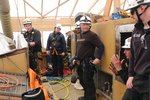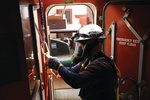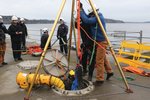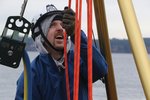Calling the fire department is something intrinsically fearful. It most likely means there’s a life on the line, there’s a squeezed clock, there’s danger. Fire departments …
This item is available in full to subscribers.
We have recently launched a new and improved website. To continue reading, you will need to either log into your subscriber account, or purchase a new subscription.
If you had an active account on our previous website, then you have an account here. Simply reset your password to regain access to your account.
If you did not have an account on our previous website, but are a current print subscriber, click here to set up your website account.
Otherwise, click here to view your options for subscribing.
* Having trouble? Call our circulation department at 360-385-2900, or email our support.
Please log in to continue |
|




Calling the fire department is something intrinsically fearful. It most likely means there’s a life on the line, there’s a squeezed clock, there’s danger.
Fire departments everywhere have a list of dangerous areas to cover, as well. In Jefferson County, the list includes the boat yard, Hood Canal Bridge, the Port Townsend paper mill. Even the forests could catch fire.
But some spaces are even more inherently dangerous; places where humans aren’t meant to fit.
For firefighters, getting ready for such claustrophobic compartments takes “confined space rescue” training. Following a successful session at Port Townsend Paper Corporation, firefighters from both the East Jefferson and Bremerton fire departments met at Boat Haven Wednesday and on Hood Canal Bridge Thursday for more specialized education.
WHY THEY TRAIN
East Jefferson Fire Chief Bret Black and Assistant Chief Pete Brummel pulled in Tom Pendley, a highly experienced instructor and retired firefighter, to lead the session.
On Wednesday, a group of about 20 emergency responders stood still listening for direction before Pendley began to speak on the nuances of the upcoming exercise.
Black said that because situations at these locations require such specialized training, a significant-sized group is necessary when the call comes in.
“If this were a real emergency it would take all of us,” Black said.
Brummel explained that it’s important for firefighters on both sides of Hood Canal to be ready for such scenarios.
“Regional teams have the same capabilities over in Kitsap County, so we train to the same level. So in a situation like this, if it’s a different type of rescue, then we have resources coming that are trained to the same level,” he said.
These kinds of rescues have strict state and federal safety, he added.
“It’s pretty intense,“ Brummel said.
Confined space rescues are necessary in intense work zones where an individual might become incapacitated from carbon monoxide exposure, or trip and fall within a difficult-to-reach crevice, especially when the fall results in injury or loss of consciousness.
While the mill, the boat yards, and the bridge have plans to mitigate potential risks in confined spaces, there are always unexpected scenarios.
Pendley described the multitude of case studies where the unplanned did happen despite safety precautions: “We know historically they have a plan for this stuff. But there’s a giant stack of incidents where it’s just freak things, they didn’t expect it, places they’ve been going for years and it was always safe. And suddenly something weird happened.”
“Then it becomes a technical rescue and they call us,” Pendley said.
BENEATH THE BRIDGE
So many commuters take the Hood Canal Bridge every day or every week, often forgetting its magnitude.
But the bridge is truly an operation, being the longest floating bridge on saltwater in the world. Its stature became very clear on Thursday as fire crews waited for carbon monoxide to dissipate in the two stacked 20-foot-deep concrete holds, where rescuers would soon descend 40 feet beneath the surface of Puget Sound.
The great, empty caverns do require occasional maintenance, which state transportation crews are trained to do safely.
But, as Pendley made clear, accidents happen. Reliable tasks don’t go as planned, atmosphere monitors fail.
Then it’s important for the fire department to be familiar with those spaces and how to get in and out without harm.
During Thursday’s training exercise, fire teams opened one of the many manhole covers methodically scattered across the bridge’s lower deck and began using forced air to accelerate the dissipation of carbon monoxide.
A safe amount, while still requiring masks and umbilical oxygen, is 10 parts per million. When the crew arrived, their monitors read the massive concrete cells at 20 parts per million (PPM).
“The atmosphere is the real deal, guys,” Pendley reminded the team as they finally prepared to begin training at 10 PPM about an hour later.
Brummel described the scenario in play: “You got a report of a worker down below, became incapacitated when his meter failed.”
They began setting up a harness tripod over the open manhole, working carefully around the big channels of forced air.
Everyone worked quietly in the 30 degree winds sailing over the canal, licking the deck.
The “victim” was dangled into the cell by harness, the work of several men guaranteeing his safety as he dropped over 20 feet into darkness. His two rescuers followed. The team on deck maintained countless fail-safes in the vicinity of the manhole, down to the smallest details.
Once the oxygen concern lessened, and multiple rounds of safety checks were conducted, the rescue was fairly straightforward. The “victim” was back in the murky winter light in about 20 minutes, despite a couple minor setbacks, which trainers said are inevitable in a first-time setting.
BOAT HAVEN RESCUE
The previous day saw a greater challenge, however.
After spending the morning training on the “Western Flyer” (known as Steinbeck’s charter fishing boat), they headed to “Hawaiian Chieftain,” a 1988 tall-ship stylized as a 19th-century trading vessel (and sister to “Lady Washington,” one of the stars of “Pirates of the Caribbean”).
The plan was to enact a rescue in which a shipwright had fallen within the drive shaft and became incapacitated.
Pendley, along with Black and Brummel, intended to enforce the most rigorous exercise possible to make sure their teams are prepared for the worst.
When the clock started, the men began unloading the rescue truck, strapping into harnesses, and preparing the space for a safe rescue mission.
That included unraveling the color-coded umbilical cords from life-giving technical suitcases filled with instruments. The cords served as the mens’ life lines when they descended into the hull, providing unlimited oxygen to their masks and a heavily reinforced bread-crumb-trail back to safety. The cords also contain hard-lined communication, running to microphones nestled in the rescuers’ necks, making clear dialogue as streamlined as possible.
The four men dressed to descend as rescuers strapped smaller oxygen tanks to themselves for the unlikely scenario their umbilical lines became compromised.
When a firefighter uses that tank, it’s an emergency situation. Between heavy exertion, difficult environments, and adrenaline, the tank meant to last 15 minutes, will likely last half that, Pendley said.
Aboard the Chieftain, previously complex, unfamiliar, and impressive work environment transformed in minutes to an even more foreign affair. While it was outlandish, it felt secure. Under the temporary house that protects her deck from the elements, the group of men had established a multitude of fail-safes, ready systems, and anchorage points.
THE ROUTE
Along with the firefighters’ easily circulating technical chatter and work, the shipwrights continued work down below; the sounds of welding and hammering were constant throughout the exercise.
The team double-checked their preparedness lists and equipment while Black explained, “We move at half- or even quarter-speed because there are case studies upon case studies where things don’t go as planned. So this may seem a little slow, but it’s on purpose, ‘cause we want to make sure we’re training as safe as possible.”
He said despite their best attempts, injuries do still happen on occasion during training.
It’s because of this, and in the general interest of safety, that they try to keep training environments fairly sterile, Black explained.
The scenario may call for a rigorous rescue, but unnecessary obstacles aren’t put into place.
Brummel said the goal is to make it “dynamic enough without making it more complicated — we try to make it realistic without adding unexpected risks.”
The rigorous course, however, was quite the contender.
The victim, Ty Seely, was in a small opening in the floor of the hull, which lead to the drive shaft. About four descending steps from the deck and a kneel would put rescuers face-to-face with Seely.
But no one here was interested in quick and easy.
As Seely nestled down into the floor, Pendley gestured to the opposite end of the deck where another door lead to various channels and corridors meandering down within the Chieftain.
“So, you’d think the easiest thing to do would be go down the stairs get him and bring him out so we’re gonna send them [the other] way and down the steps, through the hold, underneath through another hole, through the motor, underneath another hold, to come out down there. Then they have to come out the same way,” he said.
Not only was the team navigating the complexities of a dark hull in heavy gear, they were returning with Seely, who was playing his part well as an incapacitated victim after being packaged up tidily on a flexible gurney that the men dragged through the ship.
While the rescuers went in wearing oxygen, they would only mask the victim if their sensors warn that oxygen levels have dipped beneath 20 percent.
In a rescue mission, that protocol ensures that if the atmosphere should change, the rescuers won’t need rescuing, and can quickly aid the victim.
IN THE THICK OF IT
As Seely was dragged around tight corners, through narrow doorways, along uneven floors, Brummel called out directions here and there: “Watch his head. Do we have good airways?”
Otherwise, there was only the chorused mask-breathing of the rescuers in the dark channels, amidst the sounds of rustling and scraping.
Their head lamps swung irregular light across the space as they worked; the only other visibility derived from working gaps in the ship’s belly, where the light made strange thin lines on ruddy metal angles covered in soot. They were surrounded by gears and teetered on metal plates bridging gaps over exposed chasms.
Their communication was hardly perceptible beneath their masks, but there were hazed mumbles that seemed to correspond with the distant voices above deck, sometimes followed by laughter.
Once in the engine compartment, Seely was resting against a small set of metal stairs, where he was backlit by a line of peeking sun reflecting off the gravel below.
He was strangely discount akimbo as he waited for his rescuers to evaluate their next steps. He could’ve been taking a lunch break if his body wasn’t completely rigged up like a splint and his hands secured peacefully into his chest.
He had a passive, mild impatience behind his safety glasses.
“Don’t let him fool ‘ya, the hardest job is being the victim,” Seely said.
“Because you want to help?”
“Because you want to help,” he responded.
Brummel’s chuckle echoed from further back in the engine where he was observing the rescue, “Yeah, there’s a great gift of faith that they’re not gonna drop you or smash your face.”
It seemed appropriate that Seely’s hands were tied, which served both to protect the “incapacitated victim’s” hands from swinging about freely, risking getting caught somewhere but also to keep him from being tempted to help his teammates.
In a tangle of head lamps and equipment, with one man feigning unconsciousness, each turn and crowded corridor proved daunting.
But eventually, everyone was above deck again. The men went to work helping one another free themselves of heavy gear as they reorganized before a debrief of the exercise.
DEBRIEFING
The men all spoke freely and confidently about what they felt could improve or what they may have done wrong.
When a certain critique came up, one of the rescuers explained his reasoning as he looked to Seely; “I was worried your airways were constricted. I worried you couldn’t breath.”
“Yep, you caught it,” Seely agreed.
Everyone sort of chuckled but was reminded that attention to detail is paramount.
If Seely had truly been non-verbal, then noticing his difficulty breathing could be the difference between life or death.
Pendley laughed a bit, too, before swinging the group back to reality.
“It happens, right sure, but just remember it’s your buddies on the line down there.”
He stressed the importance of minding details and maintaining good communication, especially when it comes to oxygen and their umbilical cords staying reliable.
“Good line management can make or break you if you’re not paying attention,” he said.
“It’s huge. And that’s why we train, right?”